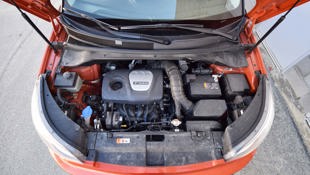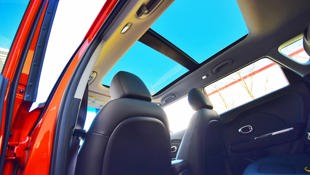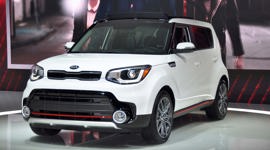Vehicle Type
Compact crossover
History/Description
The all-new, second-generation Kia Soul hit dealer lots in Canada for model year 2014, bringing along more of the utility, style, and character that made its predecessor famous. Leveraging global design resources and the latest communication, safety, and performance technologies, the second-generation Soul had advanced on all fronts.
Shoppers considering upgrading from an earlier-generation unit will likely notice a more comfortable and quiet drive, improved handling, more interior space, and a more refined overall feel on the road.
Playful colours, dynamic styling, and a distinctive new interior are some of the ways that Kia helped create a more appealing package than ever. Further, plenty of customization, options, and packages should help make it easy to find the perfect used Soul for virtually any taste.
Feature content included interior LED accent lighting, two-row heated seats, climate-controlled front seats with heat and cool functions, the UVO voice-command interface, full multimedia connectivity, a sunroof, available Infinity stereo system, back-up camera, and more.
Engines
All models were front-wheel drive, and propelled by four-cylinder engines, featuring gasoline direct injection (GDI) for added power and efficiency. Transmission choices included six-speed units in the driver’s choice of automatic or manual. Engine choices included four-cylinder units with 1.6 or 2.0 litres of displacement, with output from the larger unit here maxing out around 160 horsepower. A turbocharged 1.6-litre engine, with 201 horsepower, was available from 2017.
An all-electric Kia Soul EV was also offered, though we’ll cover that specialty model with its own story.
What Owners Like
Soul owners commonly report solid overall value, a good level of feature content for their dollars, punchy performance from the Soul’s higher-output engines, and a very easy-to-drive character, backed by easy maneuverability, entry, and exit. Outward visibility and a commanding driving position are also appreciated, as is cargo space and flexibility.
What Owners Dislike
Common complaints include a too-plasticky feel to some parts of the Soul’s cabin, wind noise at higher speeds, and a rough ride on certain surfaces – though this may be a function of the equipped wheel and tire packages. Remember, generally, that smaller wheels with thicker tires tend to translate into a more comfortable ride.
Pro Tip: Check for Rust
Check for rust, especially in areas where a small chip or other damage compromises the outer protective layer of the Soul’s paint. Some owners have complained of less-than-stellar durability from the finish on some models, though many variables are at play. In any case, carefully scour the Soul’s body for signs of rust, and ideally, have small chips or other blemishes fixed as soon as possible. Be sure to check the lower, inner edge of all doors, the hood, and the tailgate for signs of rust that may be forming within. Door hinges should also be inspected.
Pro Tip: Check the Alignment
Be on the lookout for signs of alignment trouble – which can cause accelerated tire wear, excessive fuel consumption, and a degradation of handling and braking performance. On the road, be on the lookout for a shake or vibration from the Soul’s front end, a tendency to pull to one side or another, or a steering wheel that rests off-centre with the vehicle travelling straight.
Tires can also be visually inspected for signs of alignment problems, which may be evidenced by uneven wear across the width of the treads. Check all four tires. At any sign of an alignment issue, have a technician assess the vehicle before you agree to purchase.
The Test Drive
Check for Wet Carpeting
On all units equipped with a sunroof, test-drivers are advised to remove all interior floor mats and thoroughly inspect all accessible carpeted surfaces for signs of dampness or mildew. Some owners have reported water leaks into the cabin of the vehicle, which tend to allow water to seep into the carpeting. Check carefully for signs of unwanted leaks, which could damage the vehicle.
If you notice any, the likely culprit is the sunroof – possibly by way of blocked drainage passageways that allow water to overflow from the sunroof drainage channels and find its way into the vehicle. Other causes are possible as well. Buying a used vehicle with an unaddressed interior leak of this sort is not advised – though the fix (e.g. cleaning the sunroof drain tubes) may be simple.
Test the Acceleration
On the road, be sure to accelerate at light, moderate, and full throttle, and to stop the vehicle completely from a variety of different speeds, at varying rates. For instance, slowly stop the car from 50 km/h, and then quickly stop the car from 80 km/h, and then slowly stop the car once again from 100 km/h. Do this several times, and be on the lookout for any hesitation or lumpiness to the power delivery during acceleration, or any sign of the engine struggling to run as the vehicle comes to a stop. This may be evidenced by a drop in engine rpm, or a sensation that the vehicle might stall.
Though reported relatively rarely, problems like those described above tend to be centred around a restricted fuel line, one or more bad engine sensors, or one or more bad ignition system components. If the Soul you’re considering doesn’t seem to be running quite right, be sure to have a Kia technician check it over before you buy. Note that these symptoms may be more obvious when the engine is warmed up to operating temperature after a few minutes of driving.
Test the Air Conditioner
Several owners have reported random and wonky problems with air conditioner operation, while most have not. On your test drive, confirm proper operation of the Soul’s A/C system in several situations – including while the vehicle is parked and not in motion. Note that the A/C may weaken or cut off momentarily when hard acceleration is requested.
If the A/C system in the Soul you’re considering seems to be weak or sporadic, check the cabin air filter (instructions are in the owner’s manual). A clogged cabin air filter is a likely cause of A/C problems. If the filter is in good shape, have a technician assess the vehicle before you buy.
Engine Recall
Like most vehicles, the Kia Soul from this generation was subjected to several safety recalls, which are intended to address latent safety defects. Dealers must perform safety recall work, free of charge. Not all Kia Soul models were recalled, but some were.
With the VIN number of the vehicle you’re considering, a Kia representative (1–877–542–2886) or dealer service advisor can check to determine which, if any, recall work may be outstanding on the model you’re considering. You can also check for applicable recalls using the Kia website.
There’s a full list of recalls for this generation of Kia Soul here. Note that one of these recalls covers nearly 9,000 units equipped with the 1.6-litre engine, which may need to be inspected and repaired to prevent an overheating issue that could cause sudden engine failure while the vehicle is driving. Contact a dealer service advisor for more details.
Check Oil Regularly
On your test drive, and every week during ownership, check the Kia Soul’s engine oil, following the instructions in the owner’s manual precisely. Some owners have reported excessive oil consumption from 2.0-litre engines, possibly resulting in engine failure. Here’s some more reading. Note that the vast majority of owners have not experienced this problem.
For further protection, close monitoring of oil levels, and strict adherence to oil change intervals, is highly advised. At the first sign of oil consumption problems in an in-warranty Soul, have the vehicle assessed by a dealership, and keep a copy of the report. This may speed future warranty claims, if needed. Specific oil-change requirements and information are located in the owner’s manual, and should be followed precisely.
Long-haul Engine Care
All Soul models from this generation run gasoline direct injection (GDI) technology to enhance fuel efficiency and performance. For maximum long-term reliability of this engine, owners are advised to follow a few steps. First, fuel only with high-quality fuel (at the octane specified in the owner’s manual). Second, strictly follow all fluid change and maintenance intervals, precisely, as outlined in the owner’s manual. Third, ensure spark plug changes are carried out not a moment past the mileage interval outlined in the owner’s manual, and the earlier the better.
Verdict
In all, the latest-generation Kia Soul seems to be a relatively solid buy – with most serious problems being reported with insufficient frequency to warrant much concern, and more commonly reported problems being relatively easy to check for, by a well-informed shopper. If you have no concerns after following the steps above, consider a pre-purchase inspection (PPI) at a Kia dealer ahead of your purchase, and then buy confidently.
Crash Test Results
IIHS: Top Safety Pick (2016)
NHTSA: 5/5 Stars (2017)

































